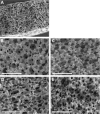Biostable scaffolds of polyacrylate polymers implanted in the articular cartilage induce hyaline-like cartilage regeneration in rabbits
- PMID: 28574106
- PMCID: PMC6379805
- DOI: 10.5301/ijao.5000598
Biostable scaffolds of polyacrylate polymers implanted in the articular cartilage induce hyaline-like cartilage regeneration in rabbits
Abstract
Purpose: To study the influence of scaffold properties on the organization of in vivo cartilage regeneration. Our hypothesis was that stress transmission to the cells seeded inside the pores of the scaffold or surrounding it, which is highly dependent on the scaffold properties, determines the differentiation of both mesenchymal cells and dedifferentiated autologous chondrocytes.
Methods: 4 series of porous scaffolds made of different polyacrylate polymers, previously seeded with cultured rabbit chondrocytes or without cells, were implanted in cartilage defects in rabbits. Subchondral bone was injured during the surgery to allow blood to reach the implantation site and fill the scaffold pores.
Results: At 3 months after implantation, excellent tissue regeneration was obtained, with a well-organized layer of hyaline-like cartilage at the condylar surface in most cases of the hydrophobic or slightly hydrophilic series. The most hydrophilic material induced the poorest regeneration. However, no statistically significant difference was observed between preseeded and non-preseeded scaffolds. All of the materials used were biocompatible, biostable polymers, so, in contrast to some other studies, our results were not perturbed by possible effects attributable to material degradation products or to the loss of scaffold mechanical properties over time due to degradation.
Conclusions: Cartilage regeneration depends mainly on the properties of the scaffold, such as stiffness and hydrophilicity, whereas little difference was observed between preseeded and non-preseeded scaffolds.
Conflict of interest statement
Conflict of interest: None of the authors has financial interest related to this study to disclose.
Figures






Similar articles
-
Time evolution of in vivo articular cartilage repair induced by bone marrow stimulation and scaffold implantation in rabbits.Int J Artif Organs. 2015 Apr;38(4):210-23. doi: 10.5301/ijao.5000404. Epub 2015 Apr 29. Int J Artif Organs. 2015. PMID: 25952995
-
In vivo evaluation of 3-dimensional polycaprolactone scaffolds for cartilage repair in rabbits.Am J Sports Med. 2010 Mar;38(3):509-19. doi: 10.1177/0363546509352448. Epub 2010 Jan 21. Am J Sports Med. 2010. PMID: 20093424
-
One-step articular cartilage repair: combination of in situ bone marrow stem cells with cell-free poly(L-lactic-co-glycolic acid) scaffold in a rabbit model.Orthopedics. 2012 May;35(5):e665-71. doi: 10.3928/01477447-20120426-20. Orthopedics. 2012. PMID: 22588408
-
Advances in autologous chondrocyte implantation and related techniques for cartilage repair.Dan Med J. 2013 Apr;60(4):B4600. Dan Med J. 2013. PMID: 23651721 Review.
-
Cartilage Tissue Regeneration: The Roles of Cells, Stimulating Factors and Scaffolds.Curr Stem Cell Res Ther. 2018;13(7):547-567. doi: 10.2174/1574888X12666170608080722. Curr Stem Cell Res Ther. 2018. PMID: 28595567 Review.
References
-
- Nelson L., Fairclough J., Archer C.W. Use of stem cells in the biological repair of articular cartilage. Expert Opin Biol Ther. 2010; 10(1): 43–55. - PubMed
-
- Insall J. The Pridie debridement operation for osteoarthritis of the knee. Clin Orthop Relat Res. 1974; 101: 61–67. - PubMed
-
- Steadman J.R., Rodkey W.G., Briggs K.K., Rodrigo J.J. [The microfracture technic in the management of complete cartilage defects in the knee joint]. Orthopade. 1999; 28(1): 26–32 [Article in German]. - PubMed
-
- Hangody L., Kish G., Kárpáti Z., Udvarhelyi I., Szigeti I., Bély M. Mosaicplasty for the treatment of articular cartilage defects: application in clinical practice. Orthopedics. 1998; 21(7): 751–756. - PubMed
-
- Minas T., Nehrer S. Current concepts in the treatment of articular cartilage defects. Orthopedics. 1997; 20(6): 525–538. - PubMed
MeSH terms
Substances
LinkOut - more resources
Full Text Sources
Other Literature Sources

